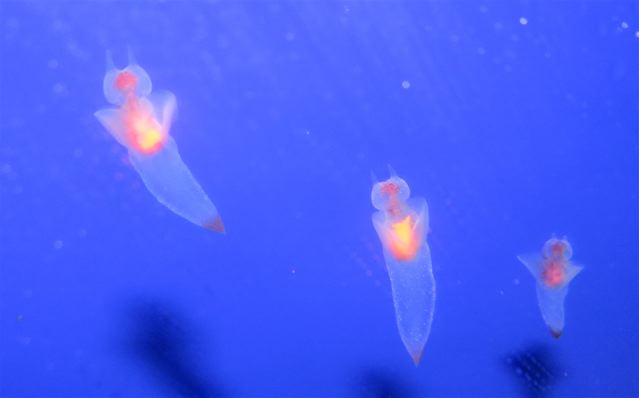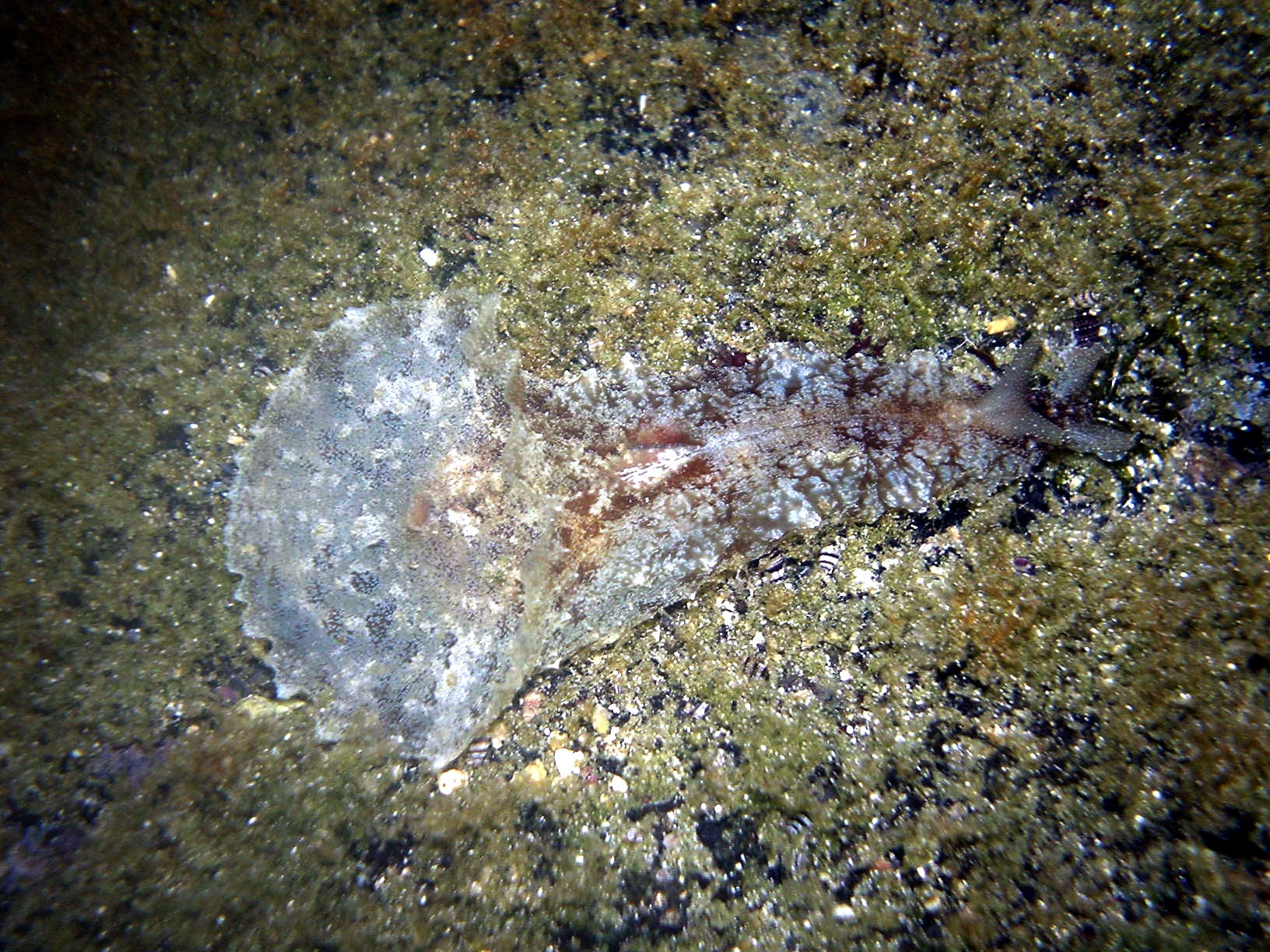|
Euopisthobranchia
Euopisthobranchia is a taxonomic clade of snails and slugs in the clade Heterobranchia within the clade Euthyneura. This clade was established as a new taxon by Jörger et al. in October 2010. Euopisthobranchia is a monophyletic portion of the Opisthobranchia as that taxon was traditionally defined but is not a replacement name for that group as several marine opisthobranch orders including Nudibranchia, Sacoglossa and Acochlidiacea are not included. Euopisthobranchia consist of the following taxa: * Umbraculoidea * Anaspidea * Runcinacea * Pteropoda * Cephalaspidea s.s. Gizzard Previous studies discussed the gizzard (i.e. a muscular oesophageal crop lined with cuticula) with gizzard plates as homologous apomorphic structures supporting a clade composed of Cephalaspidea s.s., Pteropoda and Anaspidea. A gizzard with gizzard plates probably originated in herbivorous taxa in which it worked like a grinding mill, thus might be secondarily reduced in carnivorous groups within ... [...More Info...] [...Related Items...] OR: [Wikipedia] [Google] [Baidu] |
Umbraculoidea
Umbraculoidea is a superfamily of unusual false limpets with a thin soft patelliform shell, marine gastropod molluscs in the clade Umbraculida, within the clade Euopisthobranchia. There are two families in this superfamily, which is listed as the only superfamily in the clade Umbraculida within the informal group Opisthobranchia in the taxonomy of Bouchet & Rocroi (2005). Taxonomy A study by Grande ''et al.'', published in 2004, concluded that Umbraculoidea was a sister clade to the Cephalaspidea (Acteonoidea excluded). 2005 taxonomy Umbraculoidea contains two families: *Family Umbraculidae *Family Tylodinidae Tylodinidae is a family of sea snails or false limpets, marine opisthobranch gastropod mollusks in the superfamily Umbraculoidea. Taxonomy 2005 taxonomy The family Tylodinidae consists of the following subfamilies (according to the taxonom ... 2010 taxonomy Jörger et al. (2010) moved Umbraculoidea to the Euopisthobranchia. Footnotes External links ... [...More Info...] [...Related Items...] OR: [Wikipedia] [Google] [Baidu] |
Heterobranchia
Heterobranchia, the ''heterobranchs'' (meaning "different-gilled snails"), is a taxonomic clade of snails and slugs, which includes marine, aquatic and terrestrial gastropod mollusks. Heterobranchia is one of the main clades of gastropods. Currently Heterobranchia comprises three informal groups: the lower heterobranchs, the opisthobranchs and the pulmonates.Bouchet P. & Rocroi J.-P. (Ed.); Frýda J., Hausdorf B., Ponder W., Valdes A. & Warén A. 2005. ''Classification and nomenclator of gastropod families''. Malacologia: International Journal of Malacology, 47(1-2). ConchBooks: Hackenheim, Germany. . . 397 pp. http://www.vliz.be/Vmdcdata/imis2/ref.php?refid=78278 Diversity The three subdivisions of this large clade are quite diverse: * The Lower Heterobranchia includes shelled marine and freshwater species. * Opisthobranchia are almost all marine species, some shelled and some not. The internal organs of the opisthobranchs have undergone detorsion (unwinding of the visc ... [...More Info...] [...Related Items...] OR: [Wikipedia] [Google] [Baidu] |
Euthyneura
Euthyneura is a taxonomic infraclass of snails and slugs, which includes species exclusively from marine, aquatic and terrestrial gastropod mollusks in the clade Heterobranchia. Euthyneura are characterised by several autapomorphies, but are named for euthyneury. They are considered to be the most successful and diverse group of Gastropoda. Within this taxon, the Gastropoda have reached their peak in species richness and ecological diversity. This obvious evolutionary success can probably be attributed to several factors. Marine Opisthobranchia, e.g., have evolved several clades specialised on less used food resources such as sponges or cnidarians. A key innovation in the evolution of Pulmonata was the colonization of freshwater and terrestrial habitats.Klussmann-Kolb A., Dinapoli A., Kuhn K., Streit B. & Albrecht C. (2008). "From sea to land and beyond – New insights into the evolution of euthyneuran Gastropoda (Mollusca)". ''BMC Evolutionary Biology'' 2008, 8: 57. . Vari ... [...More Info...] [...Related Items...] OR: [Wikipedia] [Google] [Baidu] |
Cephalaspidea
The order Cephalaspidea, also known as the headshield slugs and bubble snails, is a major taxon of sea slugs and bubble snails, marine gastropod mollusks within the larger clade Euopisthobranchia.Jörger K. M., Stöger I., Kano Y., Fukuda H., Knebelsberger T. & Schrödl M. (2010). "On the origin of Acochlidia and other enigmatic euthyneuran gastropods, with implications for the systematics of Heterobranchia". ''BMC Evolutionary Biology'' 10: 323. . Bubble shells is another common name for these families of marine gastropods, some of which have thin bubble-like shells. This clade contains more than 600 species. Members of this worldwide clade used to be considered the most primitive of the opisthobranchs, but now they are considered as derived and specialized members of the Euthyneura Spengel, 1881. Headshield slugs are the most morphologically diverse group of all the opisthobranchs. Anatomy The vast majority possess a shell, although it may be reduced or internal. They have ... [...More Info...] [...Related Items...] OR: [Wikipedia] [Google] [Baidu] |
Opisthobranchia
Opisthobranchs () is now an informal name for a large and diverse group of specialized complex gastropods which used to be united in the subclass Opisthobranchia. That taxon is no longer considered to represent a monophyletic grouping. Euopisthobranchia is a taxon containing a revised collection of opisthobranchs, and that taxon is considered monophyletic. Euopisthobranchia does not include some "traditional" opisthobranchs such as the Sacoglossa and the Acochlidiacea. The subclass Heterobranchia now contains all the species which used to be assigned to Opisthobranchia, plus all the species in the Pulmonata. The subclass Opisthobranchia included species in the order Cephalaspidea (bubble shells and headshield slugs), the sacoglossans, anaspidean sea hares, pelagic sea angels, sea butterflies, and many families of the Nudibranchia. ''Opisthobranch'' means "gills behind" (and to the right) of the heart. In contrast, ''Prosobranch'' means ''gills in front'' (of the heart). Opist ... [...More Info...] [...Related Items...] OR: [Wikipedia] [Google] [Baidu] |
Gymnosomata
Sea angels ( clade Gymnosomata) are a large group of small free-swimming sea slugs, not to be confused with Cnidarians (Jellyfish and other similar creatures), classified into six different families. They are pelagic opisthobranchs in the clade Gymnosomata within the larger mollusc clade Heterobranchia. Sea angels were previously referred to as a type of pteropod. Sea angels are also sometimes known as "cliones" but this is potentially misleading because the family Clionidae is just one of the families within this clade. Recent molecular data suggest the Gymnosomata form a sister group to the Thecosomata (other planktonic, weakly or nonmineralized gastropods), but this long-standing hypothesis has also had some recent detractors. Fossils of the group go back to the Middle Frasnian stage of the Late Devonian period. Distribution These organisms have a wide geographic range, from polar regions, under sea ice, to equatorial (tropic) seas. Description In this clade, the foo ... [...More Info...] [...Related Items...] OR: [Wikipedia] [Google] [Baidu] |
Anaspidea
The clade Anaspidea, commonly known as sea hares (''Aplysia'' species and related genera), are medium-sized to very large opisthobranch gastropod molluscs with a soft internal shell made of protein. These are marine gastropod molluscs in the superfamilies Aplysioidea and Akeroidea. The common name "sea hare" is a direct translation from la, lepus marinus, as the animal's existence was known in Roman times. The name derives from their rounded shape and from the two long rhinophores that project upward from their heads and that somewhat resemble the ears of a hare. Taxonomy Many older textbooks and websites refer to this suborder as "Anaspidea". The original author Paul Henri Fischer described the taxon Anaspidea at unspecified rank above family. In 1925 Johannes Thiele established the taxon Anaspidea as a suborder. 2005 taxonomy Since the taxon Anaspidea was not based on an existing genus, this name is no longer available according to the rules of the ICZN. An ... [...More Info...] [...Related Items...] OR: [Wikipedia] [Google] [Baidu] |
Runcinacea
Runcinoidea is a taxonomic superfamily (according to the taxonomy of the Gastropoda by Bouchet & Rocroi, 2005) or a clade Runcinaecea (according to the Malaquias et al. (2009)) of sea slugs, marine gastropod mollusks in the order RuncinidaJörger K. M., Stöger I., Kano Y., Fukuda H., Knebelsberger T. & Schrödl M. (2010). "On the origin of Acochlidia and other enigmatic euthyneuran gastropods, with implications for the systematics of Heterobranchia". ''BMC Evolutionary Biology'' 10: 323. .MolluscaBase eds. (2021). MolluscaBase. Runcinoidea H. Adams & A. Adams, 1854. Accessed through: World Register of Marine Species at: http://www.marinespecies.org/aphia.php?p=taxdetails&id=411898 on 2021-04-12 Taxonomy 2005 taxonomy Runcinoidea was recognized as a superfamily in the clade Cephalaspidea, within the informal group Opisthobranchia in the taxonomy of the Gastropoda by Bouchet & Rocroi, 2005). They also recognized two families, Runcinidae and Ilbiidae. 2009 taxonomy Mala ... [...More Info...] [...Related Items...] OR: [Wikipedia] [Google] [Baidu] |
Acochlidiacea
Acochlidiacea, common name acochlidians, are a taxonomic clade of very unusual sea snails and sea and freshwater slugs, aquatic gastropod mollusks within the large clade Heterobranchia. Acochlidia is a variant spelling. Description These are mostly very small animals, without a shell or gills, distinguished by the visceral mass being sharply set off from the rest of the body. Being a small group with only 30 species worldwide known in 2010, and 32 species described in 2011, and 33 in 2012 (+9 undescribed ''Pontohedyle'' species), these slugs are morphologically and biologically highly aberrant and diverse, comprising a series of unusual characters (e.g. secondary gonochorism, lack of copulatory organs, asymmetric radulae). Most acochlidians live interstitially in marine sands, while some have conquered limnic systems (uniquely within opisthobranch gastropods). Taxonomy Nils Hjalmar Odhner established this taxon as a family in 1937, when he created the families Microhedylid ... [...More Info...] [...Related Items...] OR: [Wikipedia] [Google] [Baidu] |
Nudipleura
Nudipleura are a clade of sea snails and sea slugs, marine gastropod mollusks within the large clade Heterobranchia. Taxonomy 2005 taxonomy In the taxonomy of Bouchet & Rocroi (2005), the clade Nudipleura is arranged as follows: *Clade Nudipleura **Clade Pleurobranchomorpha **Clade Nudibranchia ***Clade Euctenidiacea ***Clade Dexiarchia ****Clade Pseudoeuctenidiacea ****Clade Cladobranchia *****Clade Euarminida *****Clade Dendronotida *****Clade Aeolidida 2010 taxonomy Jörger et al. (2010) have classified Nudipleura within Heterobranchia Heterobranchia, the ''heterobranchs'' (meaning "different-gilled snails"), is a taxonomic clade of snails and slugs, which includes marine, aquatic and terrestrial gastropod mollusks. Heterobranchia is one of the main clades of gastropods. Curr ... as a separate clade as follows: References External links Sea Slug Forum {{Taxonbar, from=Q4576637 ... [...More Info...] [...Related Items...] OR: [Wikipedia] [Google] [Baidu] |
Panpulmonata
Panpulmonata is a taxonomic clade of snails and slugs in the clade Heterobranchia within the clade Euthyneura. Panpulmonata was established as a new taxon by Jörger et al. in October 2010. The older name "Pulmonata" referred to a group of gastropods which were considered to be "air-breathers". This meaning certainly does not apply to the panpulmonate groups Acochlidia, Sacoglossa and Pyramidelloidea, and also was inaccurate when applied to some of the more traditional pulmonate taxa such as Siphonarioidea or Hygrophila, most members of which lack permanently air-filled lungs. However, the term Panpulmonata was chosen by Jörger et al. (2010) to provide some continuity in the terminology. Panpulmonata consists of following taxa: * Siphonarioidea * Sacoglossa * Glacidorboidea * Amphiboloidea * Pyramidelloidea * Hygrophila * Acochlidiacea (mentioned as Acochlidia) * Eupulmonata: Stylommatophora, Systellommatophora, Ellobioidea, Otinoidea, Trimusculoidea. Cladogram This cla ... [...More Info...] [...Related Items...] OR: [Wikipedia] [Google] [Baidu] |
Thecosomata
Sea butterflies, scientific name Thecosomata (thecosomes, "case / shell-body"), are a taxonomic suborder of small pelagic swimming sea snails. They are holoplanktonic opisthobranch gastropod mollusks. Most Thecosomata have some form of calcified shell, although it is often very light and / or transparent. The sea butterflies include some of the world's most abundant gastropod species, and because of their large numbers are an essential part of the food chain, and a significant contributor to the oceanic carbon cycle. The sea butterflies are included in the Pteropoda order, and are also included in the informal group Opisthobranchia. Morphology Sea butterflies float and swim freely in the water, and are carried along with the currents. This has led to a number of adaptations in their bodies. The shell and the gill have disappeared in several families. Their gastropodal foot has taken the form of two wing-like lobes, or ''parapodia'', which propel the animal through the sea by ... [...More Info...] [...Related Items...] OR: [Wikipedia] [Google] [Baidu] |




.jpg)